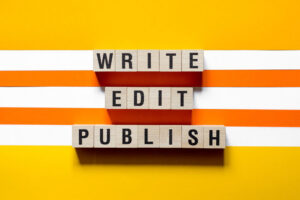Written by Rebecca Turley

Do you and your great ideas have a habit of falling short, sputtering out, or going nowhere?
Then you might need an outline.
Don’t panic.
Though the dread of outlines past might be haunting you right now, those high school teachers were actually on to something when they were pushing for outlines as a part of the writing process. And while creating an outline isn’t usually the most enjoyable part your craft, it’s a necessity if you want all that inspiration of yours to make its way into a creative piece that you’re proud of.
An Outline in Writing is More Useful and Less Restrictive Than You Might Think
 Writers who have made outlines a part of their writing process are sure to proclaim the many virtues of this literary tool. Some take to it fervently and make it a standard part of their creative process, while others create an outline out of necessity alone and with respect for its merits.
Writers who have made outlines a part of their writing process are sure to proclaim the many virtues of this literary tool. Some take to it fervently and make it a standard part of their creative process, while others create an outline out of necessity alone and with respect for its merits.
If you’re already thinking that the sort of rigid formality of an outline just doesn’t jive with your creative brain, think again. Fact is, an outline in writing can take your writing process from good to outstanding because it will help you:
Think of the outline as your blueprint—where your big idea is established, explained, and organized. It’s hard to go off the rails when you have an outline to return to, so it’s an outstanding way of staying on track. An outline in writing guides you as you write, allowing you to explore your theme, study your characters, and create your actions without fear of losing focus.
An outline serves as an excellent way to understand and refine the flow of the story. Sometimes great ideas never translate into copy because the writer failed to make sense of the story for the reader. An outline allows you to take your big idea from just an idea to a thoughtful piece that flows easily from beginning to end. It’s your opportunity to clarify your thoughts and organize a plan of attack before you begin writing.
If you have a considerable amount of information that needs to be covered in your story, an outline organizes it into manageable sections. An outline takes a would-be daunting writing task and consolidates it into smaller, more manageable tasks.
You may create an outline as part of the brainstorming process, or you may choose to get an outline in order once all the other legwork has been completed. Some writers use it as a punch list of things to do. For example, an outline may allow you to identify areas that need more work or topics that you’ll want to research. Or, if you’ve done all the prep work, an outline is an excellent way of organizing all that info to make better sense of it.
An outline in writing isn’t just beneficial for those larger written pieces like novels or screenplays. Many established writers still rely heavily on an outline for shorter pieces. It’s a heck of a lot easier to take the time to make an outline than to rework your piece. And yes – many well-established writers still turn to the trusted outline. An outline is a useful tool whether you’re an emerging writer or a veteran!
Kickstart the Brainstorming Process
Many times, your big idea is just that – an idea. Where do you take it from there? In this case, consider your outline as your brainstorming tool. It’s where a simple theme gains structure and becomes a cohesive, thoughtful, organized story. All those ideas you’ve jotted down in your journal are just begging for an outline that will transform them into your next creative masterpiece!
Don’t think of an outline in writing as stifling your creativity, either. In fact, in many cases, it can spark new ideas and reveal new ways of organizing your story. Plus, when you have the bones of your story in place through an outline, you’re free to tap into what you do best – telling your story.
Whether you scribble an outline onto a cocktail napkin or take the time to create a formal one, you’ll be glad you have it.
The Nuts and Bolts of the Outline in Writing
 An outline is how you’ll make sense of your story and its evolution. Ideas and inspiration are awesome, but they really begin to take shape and make sense when they’re written down.
An outline is how you’ll make sense of your story and its evolution. Ideas and inspiration are awesome, but they really begin to take shape and make sense when they’re written down.
An outline in writing is where you’ll gather your ideas and organize them into one, cohesive story. Your outline may be rather bare bones, serving as a general guide, or it may be highly detailed, allowing you to visualize how all of the information is connected to the story’s main theme.
Though there are certain rules that apply when creating an outline, the cool thing is that your outline can be organized as you see fit. If you stick to the standard outline that includes a list of main ideas followed by a list of details for each of those main ideas, you’re off to a good start.
An outline is pretty straightforward in terms of design and structure. It features a list of main points or ideas under which you’ll usually list more specific points that explain where those points are heading.
An outline’s structure follows the movement of the written piece, so you’ll follow it like you would the instructions to a recipe:
1. Preheat the oven.
2. Mix the dry ingredients.
3. Mix the wet ingredients.
4. Combine the wet and dry ingredients.
5. Pour mixture into a baking dish.
6. Bake for 30 minutes.
While the above main points give you an idea of how the recipe will come together, it’s clear you’re going to need more information. That’s where those more specific details come into play.
For example, in Step 2, what are the dry ingredients, and what are the measurements of those ingredients? A high-level idea of what the step entails is important, but so are the details. The details that follow the main idea are where you drill down exactly what you want that main idea to include. Your detail points will always support your main idea. So, in the case of the recipe, Step 2 may be better organized as:
2. Mix the dry ingredients
a. 2 cups flour
b. 1 cup sugar
c. 1 teaspoon baking powder
d. 1 teaspoon vanilla
Following a Linear Fashion
An outline can take on a variety of forms, but most of the time, a linear structure (start to finish) that features a combination of letters (both upper and lowercase), Roman numerals (both upper and lowercase), and/or numbers works best.
To keep your outline clear and manageable, create a parallel structure by using one alphanumeric form for each main idea and one alphanumeric form for each detail point, like this:
1. Main idea
a. Supporting Detail
b. Supporting Detail
c. Supporting Detail
2. Main idea
a. Supporting Detail
b. Supporting Detail
c. Supporting Detail
3. Main idea
a. Supporting Detail
b. Supporting Detail
c. Supporting Detail
Or like this…
I. Main idea
i. Supporting Detail
ii. Supporting Detail
iii. Supporting Detail
II. Main idea
i. Supporting Detail
ii. Supporting Detail
iii. Supporting Detail
III. Main idea
i. Supporting Detail
ii. Supporting Detail
iii. Supporting Detail
Or like this…
1. Main idea
1.1 Supporting Detail
1.2 Supporting Detail
1.3 Supporting Detail
2. Main idea
2.1 Supporting Detail
2.2 Supporting Detail
2.3 Supporting Detail
3. Main idea
3.1 Supporting Detail
3.2 Supporting Detail
3.3 Supporting Detail
You can also eliminate numbers and letters and simply use a combination of Microsoft Word bullets:
- Main idea
- Supporting Detail
- Supporting Detail
- Supporting Detail
- Main idea
- Supporting Detail
- Supporting Detail
- Supporting Detail
- Main idea
- Supporting Detail
- Supporting Detail
- Supporting Detail
- Main idea
Provided you create some sort of linear, parallel structure through a blend of numbers, letters, bullets, etc. to keep you organized and to provide a clear overview of the writing project, your outline can be organized anyway that works best for you.
For example, you may have many supporting details under each main idea, or you may just include one, broad statement detailing what the idea will include. You can even take your outline one step further and create supporting details under each detail point:
1) Main idea
a) Supporting Detail
i) Additional Supporting Detail
ii) Additional Supporting Detail
iii) Additional Supporting Detail
b) Supporting Detail
i) Additional Supporting Detail
ii) Additional Supporting Detail
iii) Additional Supporting Detail
c) Supporting Detail
i) Additional Supporting Detail
ii) Additional Supporting Detail
iii) Additional Supporting Detail
Some of the questions to ask yourself when creating an outline in writing include:
- Is my outline organized in a linear and parallel structure?
- Do all the main points have equal significance?
- Do the details support each main point?
- Does the outline provide a clear picture of my story’s structure and flow?
You can organize your outline by chapter, with each main idea of the outline breaking down the chapter. You can also organize your outline by topic or subtopic, or you can simply use your outline to organize your thoughts and determine the flow of the story. An outline is your guide and yours alone, so provided it serves as a clear framework for your project, then it’s up to you to decide its structure and design.
Unlike those high school and college theme papers that required rigid outlines and specific rules, using an outline as a creative writer involves few rules.
The Writing Outline: Even the Most Widely Read Authors Are Doing It
You may know a writer or two who flies by the seat of their proverbial pants. But many of the creative writing industry’s heavyweights agree: an outline is an invaluable part of the writing process:
“I have a number of writers I work with regularly. I write an outline for a book. The outlines are very specific about what each scene is supposed to accomplish.”
~ James Patterson, author of more than 114 New York Times bestsellers, including Along Came a Spider, Kiss the Girls, and 1st to Die
“I'm a great believer in outlines.”
~ Tom Wolfe, author of novels, short stories, and novellas, including the critically acclaimed novel, Bonfire of the Vanities (1987)
“If you do enough planning before you start to write, there's no way you can have writer's block. I do a complete chapter by chapter outline.”
~ R.L. Stine, author of novels, short stories, and screenplays, including the popular Goosebumps series of children’s books
“I force myself to outline, but not too closely, so I guess I plot by the seat of my pants? My natural instinct is to dive right in, but I know I'll get stuck. I like to stick with the architect vs. gardener metaphor. I guess I'm a gardener who plants tomatoes. I have the sticks in the ground and let the vines grow along those parameters.”
~ Victoria Aveyard, author of New York Times bestselling young adult books, including the Red Queen series of novels
“I am a big proponent of writing a great outline. That way you can avoid hitting a roadblock. There is no worse feeling than writing yourself into a corner but if you've figured it all out in the outline then you won't have that problem.”
~ Michael Showalter, writer, director, actor, and producer; co-wrote movies like My Name is Doris (2016) and The Bick Sick (2017) and co-created the critically acclaimed television series, Search Party.
Moving Beyond the Traditional Outline: The Narrative Outline
Though the alphanumeric outline is a great outline to use, the narrative outline may also be a good choice because it is created using a story idea or topic. This type of outline is much more free-from than a traditional, alphanumeric outline and includes sections of ideas rather than lists.
Each section of text (a reminder that it can be phrases or even bullet points; no need to get formal here) details the parts of the story. A narrative outline works best for shorter pieces like narrative essays and short stories that have a clear beginning, middle, and end.
A narrative outline based off a narrative essay, for example, may look like this:
- Section 1: Sets the tone of the story (main characters, setting, etc.)
- Section 2: Detail the actions that build to the climax
- Section 3: Details of the story’s climax
- Section 4: Details of how the story ends


